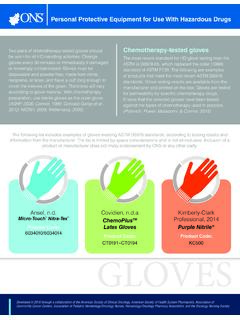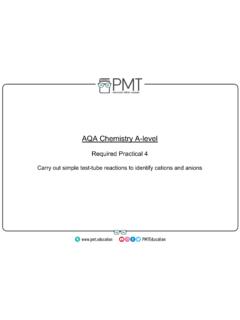Transcription of Section 2: Hazards Identification - Purple Power
1 Purple Power Cleaner/ egreaser 1 Section 1: Product and Company Identification : Product Name: Purple Power Concentrated Industrial Strength Cleaner/Degreaser Product Use: Cleaner Part# s: 4315PS, 4319PS, 4332PS, 4380DG, 4320P, 4322P, 4325P, 4330, 4340, PP275 Manufacture/Supplier: Aiken Chemical Company, Inc. Box 27147, Greenville, SC 29616 12 Shelter Drive, Greer, SC 29650 Phone Number: (864) 968-1250 1-800-828-1860 Emergency Phone: 1-800-424-9300 Date of Preparation: March 30, 2015 Section 2: Hazards Identification : Emergency Overview: Warning: Corrosive Material May Cause Burns, Irritating to Eyes and Skin. Potential Health Effects: See Section 11 for more information. Likely Routes of Exposure: Eye contact, skin contact, ingestion, and inhalation.
2 Eye: May cause burns and Irritating to eyes. Skin: May cause burns and Irritating to skin. Ingestion: May cause burns and may be harmful if swallowed. May cause stomach distress, nausea, or vomiting Inhalation: May cause respiratory tract irritation. May cause burns Chronic Effects: Prolonged or repeated contact may dry skin and cause irritation. Signs and symptoms: Symptoms may include discomfort or pain, excess blinking and tear production, with marked redness and swelling of the conjunctiva. Symptoms may include redness, edema, drying, de-fatting and cracking of the skin. Medical Conditions Aggravated By Exposure: Because of its irritating properties, product may aggravate preexisting skin, eye, and respiratory conditions. Target Organs: Skin, eyes, gastrointestinal tract, respiratory system Potential Environmental Effects: See Section 12 from more information.
3 Section 3: Composition / Information on Ingredients: Ingredient CAS# Percent Diethylene glycol monobutyl ether 112-34-5 1-5 Section 4: First Aid Measures: Eye Contact: Remove contact lenses if present. Immediately flush eyes with large amounts of water for at least 15 minutes, lifting upper and lower eyelids periodically to insure complete flushing. Seek medical attention immediately. Skin Contact: Remove contaminated clothing immediately. Thoroughly wash exposed area with soap and water for at least 15 minutes. Seek medical attention immediately. Inhalation: Remove individual to fresh air. If breathing has stopped, give artificial respiration. Seek medical attention immediately. Ingestion: DO NOT induce vomiting. If conscious, dilute by giving 2-3 glasses of water. Seek medical attention immediately General Advice: In case of accident or if you feel unwell, seek medical advice immediately.
4 Show the label or SDS where possible. Hazard Determination System (HDS): Health, Flammability, Reactivity 1 0 0 Purple Power Cleaner/ egreaser 2 Note to Physicians: Symptoms may not appear immediately. Section 5: Fire Fighting Measures: Flammability: Not Flammable by WHMIS/OSHA Criteria. Means of Extinguishing: Suitable extinguishing media: Use water fog, alcohol foam, carbon dioxide or dry chemical. Unsuitable Extinguishing Media: Not Available Products of Combustion: Not Available Explosion Data: Sensitivity to Mechanical Impact: Not Available Sensitivity to Static Discharge: Not Available Protection of Firefighters: Keep Upwind of fire. Wear full fire-fighting turn-out gear, (full Bunker gear), and respiratory protection (SCBA) Section 6: Accidental Release Measures: Personal Precautions: Use personal protection recommended in Section 8.
5 Isolate the hazard area and deny entry to unnecessary and unprotected personnel. Environmental Precautions: Not Available. Methods for Containment: Contain and/or absorb spill with inert material, ( sand, vermiculite), then place in a suitable container. Use appropriate Personal Protective Equipment, (PPE). Methods for Clean-up: Scoop up material and place in a disposal container. Provide ventilation. Other Information: Not Available. Section 7: Handling and Storage: Handling: Avoid contact with skin and eyes. Do not swallow. Do not breathe gas/fumes/vapor/spray. Use only in well-ventilated areas. Handle and open container with care. Launder contaminated clothing before reuse. When using, do not eat or drink. Wash hands before eating, drinking, or smoking. Storage: Do not store in aluminum, copper, or galvanized containers. Separate from acids, reactive metals, and ammonium salts.
6 Section 8: Exposure Controls/Personal Protections: Exposure Guidelines: Ingredient Exposure Limits OSHA-PEL ACGIH-TLV Diethylene glycol monobutyl ether: Not Available 10 ppm Engineering Controls: Use Ventilation adequate to keep exposures, (airborne levels of dust, fume, vapor, etc.), below recommended exposure limits. Personal Protective Equipment: Eye/Face Protection: Wear eye/face protection. Hand Protection: Wear suitable gloves, (Neoprene, nitrile Rubber, and Polyethylene). Skin and Body Protection: Wear body-covering, impervious clothing, chemical resistant gloves and boots. General Hygiene Considerations: Handle according to established industrial hygiene and safety practices. Section 9: Physical and Chemical Properties: Appearance and Odor: Purple liquid with Characteristic odor Physical State: Liquid pH: Freezing Point: ~2 C (~ F) Boiling Point: ~100 C (~212 F) Flash Point (Method Used): >200 F (PMCC) SAFE DA A SHEE Purple Power Cleaner/Degreaser 3 Evaporation Rate (Butyl Acetate= 1) : < LEL: Not Determined UEL: Not Determined Vapor Pressure (mm Hg.)
7 : Not Determined Vapor Density (AIR=1): Not Determined Specific Gravity: Solubility in Water: Complete Melting Point: NA Auto-Ignition Temperature: Not Determined Percent Volatile, wt%: Not Determined VOC content, wt. %: < Section 10: Stability and Reactivity: Stability: Stable under normal storage conditions. Conditions to Avoid: Mixing or blending with oxidizing or low pH solutions Incompatibility (Materials to Avoid): Avoid contact with reactive metals, strong mineral acids and organic acids. Hazardous Decomposition or Byproducts: Carbon dioxide, carbon monoxide, various hydrocarbons and can include aldehydes, ketones, organic acids and other organics. Hazardous Polymenzation: Will Not Occur. Section 11: Toxicology Information: Effects of Acute Exposure Component Analysis: Routes of entry for solids and liquids are ingestion and inhalation, but may include eye or skin contact.
8 Routes of entry for gases include inhalation and eye contact. Skin contact may be a route of entry for liquefied gases. (Poly (oxy-1, 2-ethanediyl), a-(2-propylheptyl)-w-hydroxy-): Acute Toxicity/Effects: Assessment of acute toxicity: Slightly toxic after single ingestion. Oral: LD50 judged > 500 mg/kg based on deaths at 200mg/kg (0/6) and 2000mg/kg (2/3) plus oral LD50 data on surrogate chemicals. Irritation/corrosion: Causes serious eye damage and causes skin irritation as well as, may cause irritations to the respiratory tract. Skin: Species: rabbit, Result: Irritation. Method: OECD Guideline 404 Eye: Species: Rabbit, Results: Risk of serious damage to eyes. Method: OECD Guideline 405 Sensitization: Guinea pig maximization test: Species: guinea pig. Result: Skin sensitizing effects were not observed in animal studies. Method: OECD Guideline 406.
9 Aspiration Hazard: No aspiration hazard expected. Chronic Toxicity/Effects: Symptoms of Exposure: The most important known symptoms and effects are described in the labeling, (see Section 2), and/or in Section 11. Further important symptoms and effects are so far not known. Diethylene glycol monobutyl ether: Effects, Acute Exposure: Skin Contact: May be slightly irritating Skin Absorption: Yes Toxic effects unlikely by this route unless contact is extensive in area & prolonged Eye Contact: Likely to be severely irritating (by animal testing) Inhalation: Headache, dizziness, intoxication possible, low vapor pressure makes this unlikely. Ingestion: Headache, dizziness, intoxication in severe cases, cyanosis (blue coloring), low blood pressure, & unconsciousness SAFETY DATA SHEET Purple Power Cleaner/Degreaser 4 Effects, Chronic Exposure: General: Little to no effect reported Sensitizing: Not a sensitizer in humans or animals Carcinogen/Tumorigen: Not considered a Tumorigen or a carcinogen in humans or animals.
10 Reproductive Effect: No known effect in humans or animals Mutagen: No known effect on humans or animals Synergistic With: Not Known LD50 (oral): 4500 to 9625mg/kg (rat), 2400 to 525mg/kg (mouse), 1720 to 2310mg/kg (guinea pig), and 2200mg/kg (rabbit) LD50 (skin): 2700mg/kg (rabbit) LC50 (inhalation): None exposure of rats to DB vapor (saturated at 100 C & cooled to room temp.) for 7hrs caused no mortality or other adverse symptoms Section 12: Ecological Information: Ecotoxicity: Not Available Persistence/Degradability: Not Available Bioaccumulation/Accumulation: Not Available Mobility in Environment: Not Available Section 13: Disposal Considerations: Disposal Instructions: This material must be disposed of in accordance with all local, state, and federal regulations. Section 14: Transportation Information: Proper Shipping Name: Not Regulated Hazard Class: N/A UN Number: N/A Packing Group N/A IATA: N/A Section 15: Regulatory Information: Chemical Inventories: TSCA: All components of this product are either on the TSCA 8(b) Inventory or otherwise exempt from listing.






